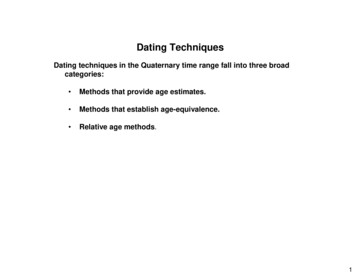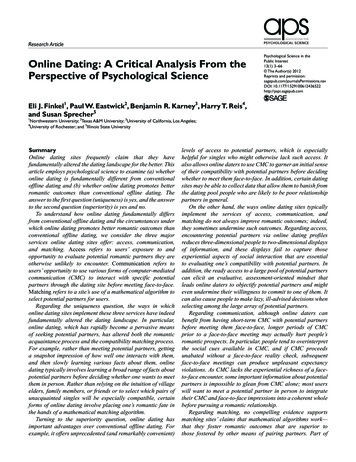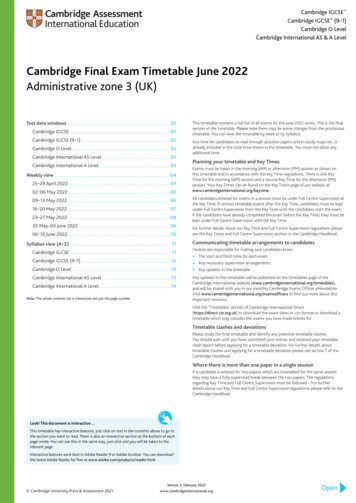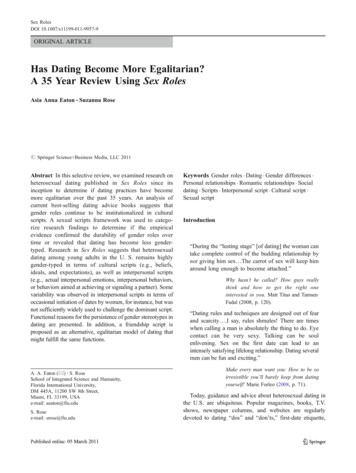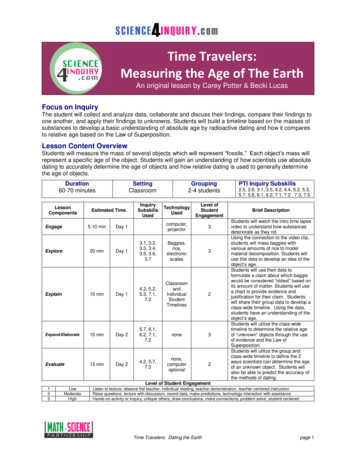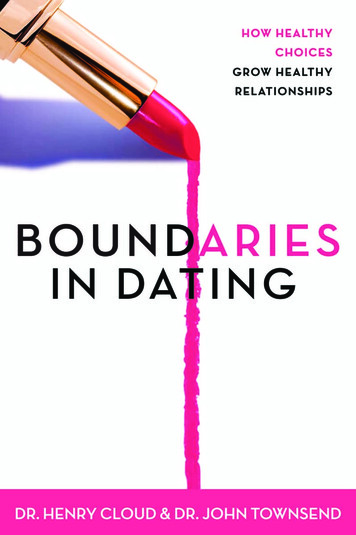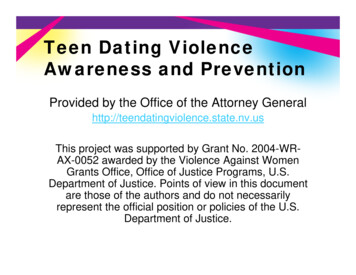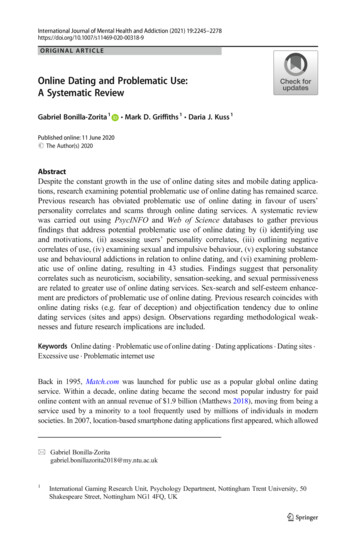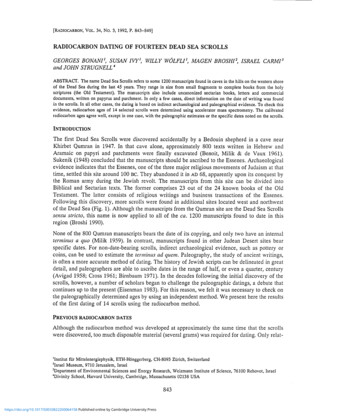
Transcription
[RADIOCARBON, VOL. 34,No. 3, 1992, P. 843-849]RADIOCARBON DATING OF FOURTEEN DEAD SEA SCROLLSGEORGES BONANI', SUSAN IVY', WILLY WOLFLI', MAGEN BROSHI2, ISRAEL CARMI3and JOHN STRUGNELL 4ABSTRACT. The name Dead Sea Scrolls refers to some 1200 manuscripts found in caves in the hills on the western shoreof the Dead Sea during the last 45 years. They range in size from small fragments to complete books from the holyscriptures (the Old Testament). The manuscripts also include uncanonized sectarian books, letters and commercialdocuments, written on papyrus and parchment. In only a few cases, direct information on the date of writing was foundin the scrolls. In all other cases, the dating is based on indirect archaeological and paleographical evidence. To check thisevidence, radiocarbon ages of 14 selected scrolls were determined using accelerator mass spectrometry. The calibratedradiocarbon ages agree well, except in one case, with the paleographic estimates or the specific dates noted on the scrolls.INTRODUCTIONThe first Dead Sea Scrolls were discovered accidentally by a Bedouin shepherd in a cave nearKhirbet Qumran in 1947. In that cave alone, approximately 800 texts written in Hebrew andAramaic on papyri and parchments were finally excavated (Benoit, Milik & de Vaux 1961).Sukenik (1948) concluded that the manuscripts should be ascribed to the Essenes. Archaeologicalevidence indicates that the Essenes, one of the three major religious movements of Judaism at thattime, settled this site around 100 BC. They abandoned it in AD 68, apparently upon its conquest bythe Roman army during the Jewish revolt. The manuscripts from this site can be divided intoBiblical and Sectarian texts. The former comprises 23 out of the 24 known books of the OldTestament. The latter consists of religious writings and business transactions of the Essenes.Following this discovery, more scrolls were found in additional sites located west and northwestof the Dead Sea (Fig. 1). Although the manuscripts from the Qumran site are the Dead Sea Scrollssensu stricto, this name is now applied to all of the Ca. 1200 manuscripts found to date in thisregion (Broshi 1990).None of the 800 Qumran manuscripts bears the date of its copying, and only two have an internalterminus a quo (Milik 1959). In contrast, manuscripts found in other Judean Desert sites bearspecific dates. For non-date-bearing scrolls, indirect archaeological evidence, such as pottery orcoins, can be used to estimate the terminus ad quern. Paleography, the study of ancient writings,is often a more accurate method of dating. The history of Jewish scripts can be delineated in greatdetail, and paleographers are able to ascribe dates in the range of half, or even a quarter, century(Avigad 1958; Cross 1961; Birnbaum 1971). In the decades following the initial discovery of thescrolls, however, a number of scholars began to challenge the paleographic datings, a debate thatcontinues up to the present (Eisenman 1983). For this reason, we felt it was necessary to check onthe paleographically determined ages by using an independent method. We present here the resultsof the first dating of 14 scrolls using the radiocarbon method.PREVIOUS RADIOCARBON DATESAlthough the radiocarbon method was developed at approximately the same time that the scrollswere discovered, too much disposable material (several grams) was required for dating. Only relat-'Institut fur Mittelenergiephysik, ETH-Honggerberg, CH-8093 Zurich, Switzerland2Israel Museum, 9710 Jerusalem, Israel3Department of Environmental Sciences and Energy Research, Weizmann Institute of Science, 76100 Rehovot, Israel Divinity School, Harvard University, Cambridge, Massachusetts 02138 USA843https://doi.org/10.1017/S0033822200064158 Published online by Cambridge University Press
844Georges Bonani et al.Fig, 1. Map of the Dead Sea region and sites where the dated scrolls werediscovered. Reprinted by permission of Atigot; courtesy of Israel Antiquities Authority.ed material from the Qumran site was dated. Libby (1951) dated the linen wrapping of a scroll.He determined a value of 1917 200 BP (conventional radiocarbon years), indicating that thecorresponding scroll might be at least 2 ka old. In 1956 and 1960, Zeuner (1969) dated pieces ofcharred date palm logs excavated at the Qumran site and obtained 1940 85 and 1965 85 BP.Dating of material from the scrolls, themselves, became feasible only after the invention ofaccelerator mass spectrometry (AMS) (Suter et al. 1984; Wolfli 1987). With AMS, samplescontaining 0.5-1.0 mg of carbon can now be dated with an accuracy comparable to that of thedecay-counting method (Bonani et al. 1987).SELECTION AND SAMPLING OF THE SCROLLSInitial sampling of the scrolls took place on 7 July, 1990 at the Rockefeller and Israel Museumsin Jerusalem. Table 1 lists the 14 scrolls finally selected for dating. A total of 20 samples (in somecases up to 3 samples from different parts of a particular scroll) were taken, photographed andweighed. Scrolls 1, 12, 13 and 14 are date-bearing documents. They span 1096 years, and wereused to test the 14C method. Detailed information on the content of the selected scrolls is in Bonaniet al. (1991).SAMPLE PREPARATIONIn the laboratory, the authenticity of each sample was verified by comparison with photos takenat the sampling in Israel. The samples were reweighed and recoiled. Each sample was split intosubsamples, which were divided into two sets. The first set was treated and measured immediately.Treatment of the second set was deferred until the radiocarbon measurement of the first set hadbeen completed. Three types of samples were dated: parchment, papyrus and linen threads thathttps://doi.org/10.1017/S0033822200064158 Published online by Cambridge University Press
Table 1. Results of "C and paleographic dating of Dead Sea Scrolls. Samples 2-6 and 9-11 are from the Qumran site. The names of the othersamples are identical with the locations of their discovery. The precise location where Scroll 12 was found is not known. Wadi Seyal ( NahalSe elim) was a general term used by Bedouin treasure hunters to mislead interested scholars.'aC agesSample ETHPaleographicno.no.S'BP)range(s)**or specifics age166373Daliyeh55BC352-351 BCt306-238 BC26640of Qahat439708236639309-235 sc332paraphrase466514t 38of Isaiah6813567896641664266436652681266505of Levi24Linen thread242of 203-117 BC125-100BC125-100BC88sc5202-107 scBC146-120 BCBC95End 2nd centurybeginning 1st century sc100-75 BC30-1 sc30-1 sct 284640scBC-AD 7432BC-AD 1432BC-AD 6150 BC-AD 70423228-12269-136,4n 130-131 AD 134#675-765AD 744#sc-an168111045BC4Apocryphon5End 1st century BCbeginning 1st century pnEnd 1st century BCbeginning 1st century nn6649121314664466456638332SeyalMirdt 36*S Number of measured subsamPles**Calibrated age ranges are given at the 1-Q leveltP Probability of finding the true ages in the respective time windows, when more than one calibrated*Specific age from date-bearing scrollhttps://doi.org/10.1017/S0033822200064158 Published online by Cambridge University Pressrangeis given00
846Georges Bonani et al.were attached to Sample 5, the Testament of Levi. All sample material was microscopically examined to identify and remove any foreign material, and to evaluate the condition of the parchment.For chemical pretreatment of the samples, we followed the standard acid-base-acid steps (see, e.g.,Damon et al. 1989). The samples were first treated in an ultrasonic bath. This was followed by hotacid, base, then acid treatments. The material was rinsed to pH 7 with distilled water between thesteps. The strength of the solution, temperature and length of time of each step depended on theability of the material to withstand the treatment. For every sample, one subsample was onlyultrasonically cleaned, whereas another subsample was ultrasonically and chemically cleaned. Thiswas done to assess the removal of contaminants of each type of treatment. The samples wereweighed before and after the cleaning procedures to determine the weight losses resulting fromeach step.Parchment samples were affected by two complications; gelatinization (Samples 9,10 and 11) andattachment of rice paper with glue, which had been used to reinforce scrolls in poor condition(Samples 4, 5, 7, 9 and 10). Microscopic examination revealed various degrees of gelatinization,estimated by darkening of the parchment from beige, when fresh, to dark brown and translucent,when extensively gelatinized. Gelatinization is described as the unfolding of the collagen structureto form gelatin (Weiner et al. 1980). This results in degradation and increased solubility of theparchment. Trial cleanings with pieces of extensively gelatinized parchment showed that most ofthe material had dissolved after our regular "strong" treatment (0.5 M HCI, 0.1 M NaOH and 0.5M HC1), as well as with one-half and one-fifth strength treatments. Thus one-tenth strength (0.05M HCI, 0.01 M NaOH and 0.05 M HCl) was used to treat all parchment samples (1st and 2nd set).Each step lasted 15-60 minutes, depending on the response of the material, in a 40-60 C waterbath. Prior to cleaning, visible pieces of rice paper were removed, and the glue was scraped offunder the microscope. A piece of rice paper removed from the Temple scroll (Sample 9) wascleaned and dated to estimate the effect of this contaminant.Papyrus samples (1st set) were chemically cleaned with 0.5 M HCl and 0.1 M NaOH, at 40 C for45 min for each step. The final acidification was done rapidly (10 min) with 0.05 M HCI, becausemuch of the material had already dissolved. To avoid similar dissolution of samples from the 2ndset, these samples were treated with 0.25 M HCI, 0.05 M NaOH and 0.25 M HCI, at 50 C for 40min (for each step). The linen threads were cleaned using 0.5 M HCI, 0.1 M NaOH and 0.5 M HClin a 40-60 C water bath, each step lasting 45 min.Following the chemical treatment, each sample was dried overnight in a 60 C oven. All of theremaining sample material, or up to 10 mg, was combusted in evacuated sealed quartz tubes, withcopper oxide and silver wire. This lasted for 2 h at 950 C. In the presence of hydrogen, the carbondioxide was reduced to filamentous graphite over a cobalt catalyst, using the method described byVogel et al. (1984) and Vogel, Southon and Nelson (1987). The resulting graphite-cobalt mixturewas pressed onto copper targets for the measurement.MEASUREMENT, DATA EVALUATION AND CALIBRATIONThe 14C/12C and 13C/12C ratios were determined quasi-simultaneously and relative to the respectiveNBS oxalic acid I and PDB standard values (Bonani et al. 1987). The conventional radiocarbonages were calculated using the procedure suggested by Stuiver and Polach (1977). They werecorrected for natural fractionation and reported in years BP (before 1950). The results listed inTable 1 are the weighted mean values of at least two independent measurements of differentlyprepared subsamples. The errors quoted are at the one-sigma (1 Q) level, and represent the statistical error of the mean or the variance, whichever is larger.https://doi.org/10.1017/S0033822200064158 Published online by Cambridge University Press
14CDating of 14 Dead Sea Scrolls847The calibrated 1 Q 14C age ranges (68% confidence levels) are also listed in Table 1. They weredetermined from the high-precision curve of Stuiver and Pearson (1986) based on dendrochronological dating. For this transformation, we used the CalibETH program (Niklaus et al. 1991) whichcalculates the probability distribution, as described by Stuiver & Reimer (1987). No additionaluncertainty has been added, assuming that the growth period of the papyrus and the lifetime of theanimals, as well as the timespan between harvesting and writing, were short compared to the othererrors involved. Because of the nature of the calibration curve, the procedure leads to doubleranges in five cases. Table 1 gives the probability of finding the true age in 1 of the 2 age ranges.RESULTS AND DISCUSSIONThe specific dates of the date-bearing scrolls and the paleographically determined age ranges, givenin Table 1, were disclosed to the participants at the Zurich AMS facility only after completion ofthe measurements. For ease of comparison, these data are displayed together with the calibrated,14C1 aage ranges in Figure 2. The true ages of the four date-bearing manuscripts (Samples 1, 12,13 and 14) lie within or close to the respective 1 a ranges. This indicates no significant methodological offset, either in the 14C method or in the calibration curve based on measurements onAmerican bristlecone pine and Irish oak trees. Good agreement between radiocarbon and paleographic dates is also observed in 9 of the remaining 10 samples. However, a slight systematic shiftbetween the calibrated radiocarbon ages and the estimates of the paleographers might be inferredfrom the data. The calibrated 14C ages are, on average, 35 years older. The statistical significanceof this offset remains to be proven.A discrepancy of approximately 200 years exists between the paleographical date and the calibratedradiocarbon dates of the Testament of Qahat (Sample 2 in Table 2). The calibrated radiocarbon1413'1211 II800ADFig, 2. Comparison of the calibrated la 14C ranges (horizontal black bars) with paleographical estimates (hatched areas)and specified dates (vertical lines). The thickness of the black bars is proportional to the probability to find the true agewithin the corresponding 1 a range. Reprinted by permission of Atigot; courtesy of Israel Antiquities 8 Published online by Cambridge University Press
848Georges Bonani et al.14Cresults of solely ultrasonically and ultrasonically and chemically cleaned subsamples of the Qahat scrollTABLE 2. Comparison of14CETH 605 48Mean values2608 37ages (yr BP)Ultrasonic and chemical2340 492246 572612 542204 462158 5539date was determined from four chemically cleaned and independently measured samples. Paleographically, the Testament of Qahat has been ascribed a date of Late Hasmonean (Bonani et al.1991). The possibility that the parchment was used for a second time (i.e., a palimpsest) can alsobe ruled out; infrared tests do not show evidence of earlier writing (Almog, personal communication 1990). It is also unlikely that the parchment was left unused for such a long period of time.However, in this case, it is difficult to rule out chemical contamination. Two separate samples,from distinct parts of the Qahat scroll, were taken at different times. In both cases, the samples thatwere only ultrasonically cleaned were approximately 350 years older than the samples that wereultrasonically and chemically cleaned (Table 2). Possible contaminants include castor oil (used, atone time, to improve the visibility of the writing), rice paper and glue. Castor oil and rice paperwould yield younger apparent ages, as they contain modem carbon. On the other hand, the glue(a petroleum product) used to attach the rice paper to the scrolls would increase the apparent ageof the scroll. Microscopic examination of the Qahat sample material did not reveal the presenceof rice paper or glue; also, the parchment was ungelatinized. It is interesting to note that a sampleof rice paper and glue removed from the Temple scroll (Sample 9) yielded an age of 6215 75BP. It should be emphasized that no similar age discrepancy was found between the solelyultrasonic and ultrasonic and chemically cleaned subsamples of the other 13 scrolls that were dated.Parchment samples from the Temple, Genesis and Thanksgiving scrolls were visibly the mostgelatinized of the scrolls that we investigated. The parchment material was uniformly dark brownand translucent. During the initial sampling, an attempt was made to obtain ungelatinized portionsin addition to samples from gelatinized edges of these scrolls. Also, additional, fresher material wasrequested from the Temple scroll. Table 3 shows the results of dating gelatinized and ungelatinizedTABLE 3. ComparisonETH no.14Cresults of gelatinized and ungelatinized scroll latinized sampleshttps://doi.org/10.1017/S0033822200064158 Published online by Cambridge University Press7837200465**52**194336Genesis3Thanksgiving*S number of measured subsamples**49**2066
14CDating of 14 Dead Sea Scrolls849samples from the same scroll. It includes the weighted averages for chemically treated and solelyultrasonically cleaned subsamples, and shows that the results agree within the stated error. Thisindicates that gelatinization does not affect the 14C age of the parchment.ACKNOWLEDGMENTSWe thank Mr. A. Drori, head of the Antiquity Authority of Israel, for his help and supportthroughout the project. We gratefully acknowledge the assistance of Irka Hajdas during the samplepreparation phase. Our thanks are due Dr. Y. Almog, Israeli Police Force Forensic Section, forconducting the infra-red tests. Part of this work was funded by the Paul Scherrer Institute, Villigenand the Swiss National Science Foundation.REFERENCESAvigad, N. 1958 The palaeography of the Dead SeaScrolls and related documents. In Rabin, C. andYadin, Y., eds., Aspects of the Dead Sea Scrolls( Scripta Hierosolymitana 1V9. Magnes Press: 56-87.Benoit, P., Milik, J. T. and de Vaux, R. 1961 Discoveries in the Judaen Desert, II. Oxford, Oxford University Press: 93-95.Birnbaum, S. A. 1971 The Hebrew Scripts. Leiden,Paleographic: 127 p.Bonani, G., Beer, J., Hofmann, H-J, Synal H-A, Wolfli,W., Pfleiderer, C., Kromer, B., Junghaus, C. andMunnich, K. 0. 1987 Fractionation, precision andaccuracy in 14C and 13C measurements, In Gove, H.E., Litherland, A. E. and Elmore, D., eds., Proceedings of the 4th International Symposium on Accelerator Mass Spectrometry. Nuclear Instruments andMethods B29: 87-90.Bonani, G., Broshi, M., Carmi, I., Ivy, S., Strugnell, J.and Wolfli, W. 1991 Radiocarbon dating of the DeadSea Scrolls. Atigot XX: 27-32.Broshi, M. 1990 The Dead Sea Scrolls discovery andidentification. Israel Museum Journal 9: 31-41.Cross, F. M. 1961 The development of the Jewishscripts in the Bible and the ancient Near East, InWright, G. E., ed., The Bible and the Ancient NearEast. London, Routledge and Kegan Paul: 133-202.Damon, P. E., Donahue, D. J., Gore, B. H., Hatheway,A. L., Jull, A. J. T., Linick, T. W., Sercel, P. J.,Toolin, L. J., Bronk, C. R., Hall, E. T., Hedges, R. E.M. , Housley, R., Law, I. A., Perry, C., Bonani, G.,Trumbore, S., Wolfli, W., Ambers, J. C., Bowman S.G. E., Leese, M. N. and Tite, M. S. 1989 Dating ofthe Shroud of Turin. Nature 337: 611-615.Eisenman, R. 1983 Maccabees, Zadokites, Christiansand Qumran. Leiden, Brill: 29-31.Libby, W. F. 1951 Radiocarbon dates II. Science 114:291-296.Milik, J. T. 1959 Ten Years of Discovery in the Wilderness of Judea. London, SCM Press: 73 p.Niklaus, T., Bonani, G., Simonius, M., Suter, M. andWolfli, W. 1992 CalibETH: An interactive computerprogram for the calibration of radiocarbon dates.Radiocarbon, this issue.https://doi.org/10.1017/S0033822200064158 Published online by Cambridge University PressStuiver, M. and Polach, H. A. 1977 Discussion: Reporting of 14C data. Radiocarbon 19(3): 355-363.Stuiver, M. and Pearson, G. W. 1986 High-precisioncalibration of the radiocarbon time scale, AD 1950500 BC. In Stuiver, M. and Kra, R. S., eds., Proceedings of the 12th International 14C Conference. Radiocarbon 28(2B): 805-838.Stuiver, M. and Reimer, P. J. 1987 User's Guide to theProgram Calib and Display Rev 2.1: Quaternary Isotope Laboratory, University of Washington, Seattle.Sukenik, E. L. 1948 Hidden Scrolls Preliminary Report.Jerusalem, Mossad Bialik (in Hebrew).Suter, M., Balzer, R., Bonani, G., Hofmann, H. J.,Morenzoni, E., Nessi, M., Wolfli, W., Andree, M.,Beer, J. and Oeschger, H. 1984 Precision measurements of 14C in AMS - some results and prospects.In Wolfli, W., Polach, H. A. and Anderson, H. H.,eds., Proceedings of the 3rd International Symposiumon Accelerator Mass Spectrometry. Nuclear Instruments and Methods B5: 117-122.Vogel, J. S., Southon, J. R. and Nelson, D. E. 1987Catalyst and binder effects in the use of filamentousgraphite for AMS. In Gove, H. E., Litherland, A. E.and Elmore, D., eds., Proceedings of the 4th International Symposium on Accelerator Mass Spectrometry.Nuclear Instruments and Methods B29: 50-56.Vogel, J. S., Southon, J. R., Nelson, D. E. and Brown,T. A. 1984 Performance of catalytically condensedcarbon for use in accelerator mass spectrometry.Nuclear Instruments and Methods B5: 289-293.Weiner, S., Kustanovich, Z., Emanuel, G-A and Traub,W. 1980 Dead Sea Scroll parchments: Unfolding ofthe collagen molecules and racemization of asparticacid. Nature 287(5785): 820-823.Wolfli, W. 1987 Advances in accelerator mass spectrometry. In Gove, H. E., Litherland, A. E. andElmore, D., eds., Proceedings of the 4th InternationalSymposium on Accelerator Mass Spectrometry.Nuclear Instruments and Methods B29: 1-13.Zeuner, F. E. 1969 Notes on Qumran. Palestine Explo-ration Quarterly 92: 27-36.
Table 1. Results of "C and paleographic dating of Dead Sea Scrolls.Samples 2-6 and 9-11 are from the Qumran site. The names of the other samples are identical with the locations of their discovery. The precise location where Scroll 12 was found is not known.Wadi Seyal ( Nahal Se elim) was a general term used by Bedouin treasure hunters to mislead interested scholars.
